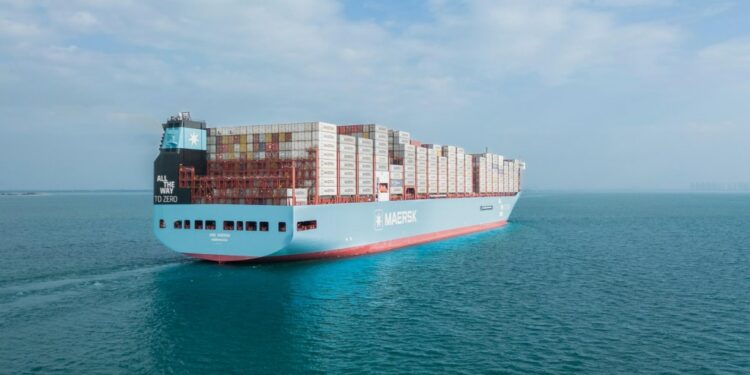We are faced with these challenges together and we need to make sure that we stay close to them as we handle the new set of circumstances that continues to unfold in front of us. These disruptions, and the impact they are having on your business, is not something that I, nor any colleagues at Maersk, take lightly. We know it is hard. We know it is difficult for you. We know it puts you under a lot of pressure.
Vincent Clerc
CEO, A.P. Moller – Maersk
Vincent Clerc talked about the “massive impacts” of the Red Sea situation since it began in December 2023. Extending rotations to travel the longer route around Africa takes two to three ships, depending on the trade in question, he said. The availability of additional capacity was low to begin with and, across the industry, carriers’ ability to bring in extra tonnage has been limited. At the same time, demand for container transport has remained strong.
Today, all ships that can sail and all ships that were previously not well utilised in other parts of the world have been redeployed to try to plug holes. It has alleviated part of the problem, but far from all the problems across the industry, including for Maersk. We are going to have in the coming month missing positions or ships that are sailing that are significant different size from what we normally would have on that string, which will also imply reduced ability for us to carry all the demand that there is.
Vincent Clerc CEO,
A.P. Moller – Maersk
Asian exports are more impacted than Asian imports by the ongoing situation in the Red Sea. This is primarily because Asian countries are major global exporters, and China is the largest exporter to many Asian countries. Routes between the Far East and Europe via the Suez Canal have been directly impacted, with disruptions in the Red Sea affecting most trade routes. However, the disruptions have extended beyond Far East-Europe routes to the entire ocean network.
Take the Oceania network, for example. Oceania’s ocean network is impacted by congestion in Southeast Asian hubs as these ports are crucial to connect Oceania’s cargo to Maersk’s global network. This is due to equipment shortages and constrained capacity from the Red Sea disruptions, which affects both alternative routes and transshipment hubs. The delays in Southeast Asian hubs pose a risk of disruption at Australian ports due to vessel bunching on arrival, resulting in longer waiting times and other delays. The congestion and disruption have extended beyond the hubs and into Northeast Asia and Greater China ports, causing delays. Oceania exporters should factor in additional lead time as part of supply chain planning during this time.
There are multiple reasons behind the domino impacts in these regions. First, hubs in Asia are being impacted with congestion across key ports, causing delays and bottlenecks to ripple through the entire system. Second, ocean networks have been reorganised with vessels being moved to different regions to better meet demand for capacity. This has led to a widening global impact that has affected regions that weren’t originally directly affected by the Red Sea disruption.
Maersk is working to minimise disruptions to our customers through key investments as well as through ongoing operational adjustments. These include securing additional containers as well as exploring further capacity enhancements. We are preparing for continued disruptions by adjusting our network and supply strategies accordingly. This includes doing our best efforts to bring supply in line with businesses’ demand for capacity.
Ocean Key Updates
Highlights
Our cargo demand remains robust globally, driven by strong Asian exports to North America and Europe. Despite the significant challenges, our focus remains on securing coverage, equipment and reliable capacity solutions. For time-sensitive goods that need to be moved quickly, our air freight service, including sea-air solution, may be used as a transport alternative.
The cascading impact of these disruptions extends beyond the primary affected routes, causing congestion at alternative routes and transshipment hubs essential for trade with Far East Asia, West Central Asia, and Europe. Ports across Asia, including Singapore, Australia, and Shanghai, are experiencing delays as ships reroute and schedules are disrupted, caused by ripple effects from the Red Sea.
We are also approaching typhoon season, which is expected to impact East China and South China, creating further risks of congestion.
Far East to North Europe: Capacity for routes from the Far East to Northern Europe remains tight due to the ongoing situation in the Red Sea. Current estimates indicate a capacity loss across the industry, while demand for shipments continues to be strong.
Far East to Mediterranean: Capacity remains tight due to rerouting and port congestion. Current estimates indicate an industry-wide capacity loss, expected to continue into Q3 2024, while demand continues to be strong.
Far East to US West Coast and US East Coast: Demand remains strong, and the capacity remains tight even though there has been extra capacity injected for Far East to US West Coast trade.
Far East to East Coast South America and West Coast South America: Capacity remains tight, while demand growth has remained strong since Q1.
Far East to West Central Asia: Strong demand for routes into India persists, limiting the available capacity. Similarly, the Middle Eastern market remains dynamic and faces limited capacity.
Far East to Africa: The market remains dynamic with strong demand but limited capacity despite additional space added on to Far East to East Africa routes in June.
Asia to Australia and New Zealand: The Oceania network continues to face disruptions due to congestion at major hub ports in Asia. Over the past three months, the total capacity has been reduced as vessels are diverted to higher-demand trade routes. Demand growth remains robust, with a significant increase in Q1.
Australia and New Zealand to Worldwide: Routes from Oceania to Europe and Middle East continue to experience tight capacity supply due to rerouting and port congestion. Market demand into India has significantly increased following the free trade agreement between India and Australia.
For Oceania to the Americas, strong demand for routes to the US East Coast and Latin America is indirectly impacted by disruptions in the Red Sea as the demand is expected to remain strong in the foreseeable future.
At Maersk we maintain a keen focus on protecting our vessel’s schedule reliability to limit impact to your supply chain, despite the current disruption. We are pleased to advise that both the Triple Star and Southern Star Services, connecting New Zealand with Greater China Area and South East Asia, are continuing to achieve above-industry-average performance, with schedule reliability in June reaching over 80%.
Intra-Asia: Intra-Asia routes are also experiencing equipment shortages, particularly out of China. This is an industry-wide issue that initially affected long-haul shipping but now has extended to intra-Asia routes. The demand for export containers in China is placing a difficult balance for carriers such as Maersk, in deciding whether to prioritise limited vessel capacity in carrying empty containers back to China or carrying laden containers to other destinations, bearing in mind the increased shipping costs. The decision, either way, contributes further to supply chain inefficiencies.
Product Spotlight of the Month
Maersk Air Cargo took delivery of the first Boeing 777 owned by a Danish airline
On 12 July 2024, Maersk Air Cargo (MAC) took delivery of its first of two new Boeing 777F. It’s the first Boeing 777 owned by a Danish airline.
Especially Maersk’s air freight customers in China and Europe will benefit from increased capacity and efficiency by the introduction of the two Boeing 777F. Both will be deployed on Maersk’s existing Europe-China route with initially three weekly flights, and later up to six weekly flights. Besides more capacity on direct routes the 777Fs will ensure shorter transit times as well as faster handling times and quality at origin and destination. Maersk ordered the two 777Fs in November 2021 as part of the modernization of its fleet. The delivery of the second aircraft is scheduled later in Q3. Maersk Air Cargo’s owned controlled fleet will then comprise of two Boeing 777F and 20 Boeing 767F. Please click here to learn more details.
Did you find this market update useful? Click below to stay updated on relevant information.
Subscribe to Asia Pacific Monthly Updates
Please do reach out to us if you have any further questions about your supply chain. We are here to navigate you through the current situation.
Reach our expert
Discuss and get closer to the answers you need to navigate efficiently around the Red Sea challenge.
Source link : https://www.maersk.com/news/articles/2024/07/17/continued-impact-of-the-red-sea-situation-on-supply-chains
Author :
Publish date : 2024-07-17 00:46:44
Copyright for syndicated content belongs to the linked Source.





